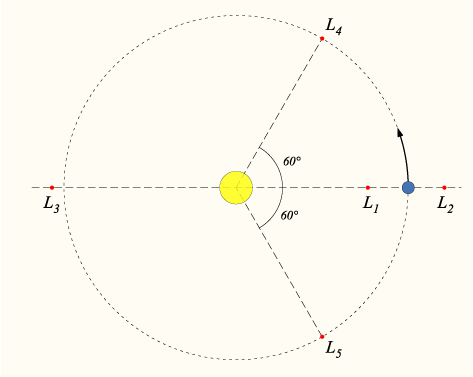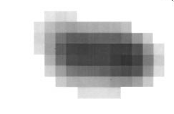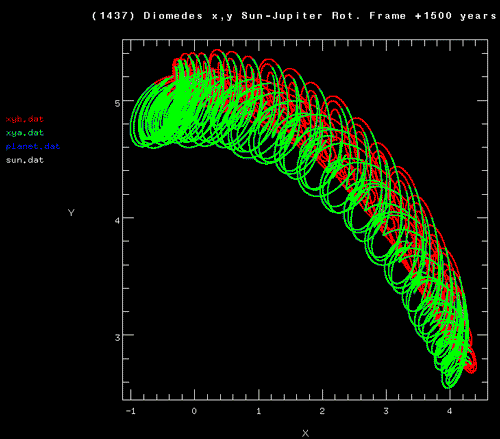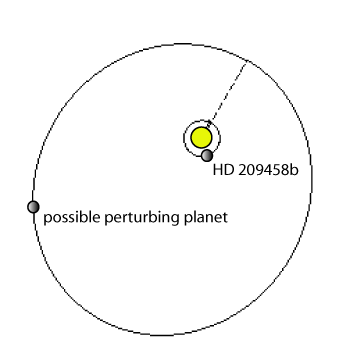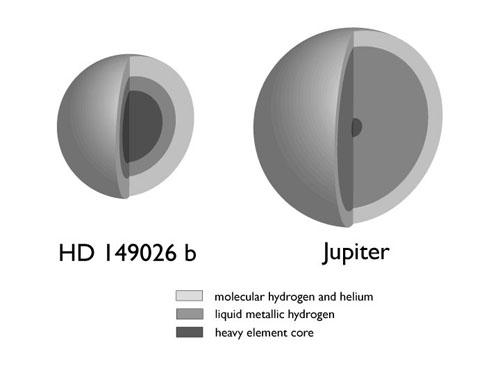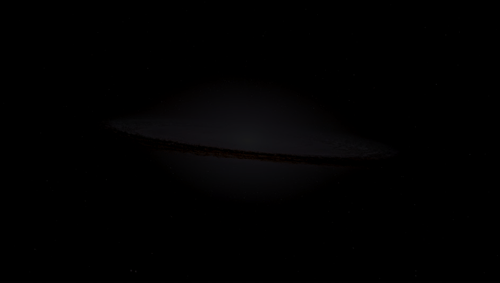We came from a black cloud.

Stated with such conviction and simplicity, the theory of planet formation is as remote and dogmatic as, say, the creation myth of the ancient Greeks: “In the beginning, there was chaos”
Going about everyday life, with the flip-top cell phone, the busy schedule, the cars with soft leather seats, traffic reports on the radio, blogs dissecting politics, the idea of planet formation, the fact that the Earth hasn’t always existed has no chance for a foothold. You must shut everything off and stare at a dark night sky.
Easier said than done. Almost certainly, your night sky does not induce much wonder. Part of my own view, for example, is blocked by the neighbor’s garage. The nearer streetlights are brighter than the full moon, and they suffuse the air in prismatic halos of light. Some stars are visible, even the best-known constellations. Orion in the winter. The Big Dipper. But on the whole, the stars hardly concern us because we can hardly see them.
To see the stars as they are really meant to be seen, you probably need to plan a trip. Look at a satellite image of the country taken at night, or better yet, use a dark sky finder java applet, and drive to the spot on a clear, warm, windless and moonless night. It is a strange condition of our state of affairs that an applet can help us obtain what was once obvious to anyone who simply looked up. A price paid for a modern world of ease and comfort. A perfectly dark clear night is now, quite literally, a commodity.

Let your eyes dark-adapt, and then look up. The effect is overwhelming. Stars. So many of them that the bright ones hardly matter. On a truly dark night, the Milky Way is unmistakable. It spills a swath of patchy luminosity across the dome of the sky. A barred spiral galaxy, seen edge-on, and from within. One hundred billion intensely glowing stars, like sand grain jewels, each separated by miles. Faced with this firmament, the idea that we came from a black cloud seems somehow more within the realm of the possible.
Black clouds, giant billowing masses of molecular hydrogen and helium laced with dust of the consistency of cigarette smoke congregate in the spiral arms of the Milky Way. Their centers are frigid, ten degrees Kelvin, and if you could watch a time-lapse movie of a million years compressed into a minute, you would see them billow and boil.
Within a cloud, the cold dense gas is always poised to collapse in on itself under its own weight. Disaster is staved off by the roiling currents in the gas, and the magnetic field lines that thread the cloud. The cloud contains a tiny fraction of charged particles, ions and free electrons that are outnumbered by neutral atoms and molecules by a factor of a billion or more.
Charged particles are tied to magnetic field lines. Motion of charges drags the magnetic field lines along, and vice versa. Magnetic field lines, however, don’t like being compressed or twisted. They have a tendency — verging on insistence — to spring back into shape. This prevents the ions and electrons from joining the gravitational collapse of the cloud. The ions and the electrons, in turn, bounce continuously against the neutral particles in the cloud, and in so doing, delay the great inward crush.
Most of the time, the frantic collisions of the ions are decisive. The great unwieldy black cloud is torn apart by the tidal forces of the galaxy before it can collapse under its own weight. The cloud dissipates like Arizona thunderheads in the face of approaching night. Occasionally, however, the ions and electrons are overwhelmed. Neutral gas slips past their efforts and pools in the centers of the clouds. This process gains momentum, the ions lose their effectiveness, and vast gulfs of the cloud begin to collapse.

Picture the scene 4.56 billion years ago when the solar system began to form. The atoms that now constitute the Earth have already been forged. Every atom of hydrogen in the molecules of the pre-solar cloud has already seen 9 billion years of history.
For some of that hydrogen, the past was uneventful. Atoms born in regions of the big bang that, by dint of the role of quantum dice, were a few parts in a million less dense than their surroundings were left cool and marooned in the stretches of space between the Milky Way and nearby galaxies. For billions of years, they fell through intergalactic space, to land, by chance, on the disk of the Milky Way just prior to the assembly of the giant molecular pre-solar cloud.
Other hydrogen atoms, some of them now vibrating in molecules massed in aqueous solution in your blood, or indentured to the long-chain monomers that form the polycarbonate shells of laptop computers, have experienced more colorful histories, having flowed, in some cases, in the oceans of now-dead terrestrial planets that orbited ancient generations of stars. Heavy atoms have less ancient pedigrees. The Earth’s carbon comes mostly from soot blown off of red giant stars. The gold was created in supernovae.
As the scene of the formation of the solar system unfolds, a gigantic volume of gas settles gradually into the core of the giant molecular cloud. where increasingly, the magnetic fields are losing their grip. At the center of the cloud, the view of the stars has long since been blotted out. It is utterly black and frigidly cold, but for ears pitched 24 octaves below middle C, it is not silent. The cloud rumbles and groans. The sound is like the ocean, like an earthquake, but it is also beyond simple description, and it permeates the vast stygian gulf.
Eventually, the cloud begins to collapse in earnest. Not all together, but from the center. As the gas in the center begins to form a protostar, the layer just above the center loses its support against gravity and begins to career inward as well. A wave of rarefaction radiates upward, triggering a downward avalanche of gas.
As the collapse picks up speed, a new effect becomes apparent. Gas that has fallen from large distances does not land on the central protostar. Rather, it falls onto a differentially spinning disk, a platter of gas and dust that orbits the actual center. The original protosolar molecular cloud harbored an ever-so-slight random component of rotation, and this rotation is eventually expressed in the form of the spinning protostellar disk. The basic principle — conservation of angular momentum — is what causes the skater to spin so fast when the arms are pulled in. For the protostellar disk, the originally outstretched arms of the cloud extended for a fraction of a light year from from the core.
The idea that the Sun and planets arose from a spinning disk of gas and dust dates to the eighteenth century. Isaac Newton, whose theory of universal gravitation explains the motion of the planets (and is thus the basis of the systemic console), was dismissive of a natural origin for the Sun and Planets. He issued a firm rejoinder against the whole idea of a natural cosmogony.
Where natural causes are at hand, God uses them as instruments in his works, but I do not think them alone sufficient for the creation.
The idea of creation as the product of natural law stems from the free-thinking spirit of the enlightenment. Georges Louis Leclerc, Comte de Buffon, formulated one of the first natural cosmogonies. His idea is that a comet struck the sun, throwing out the material that later condensed into the planets. This theory accounted for the fact that the planets all orbit the sun in the same direction. Immanuel Kant postulated that the planets arose via condensation from a spinning cloud of gas. Kant’s idea was developed later, independently, by Laplace, who imagined that the disk contracted as it cooled, leaving behind a succession of rings that fragmented to form the planets.
The idea that the Earth originally arose from a disk of gas and dust is tough to accept now (other than simply believing it because one has been told) and it was even harder to accept in the 1700s, when evidence was scarce. Laplace, in 1802, explained his theory to Napoleon, who didn’t like it. Napolean angrily exclaimed,
And who is the author of all this?
Thomas Jefferson, furthermore, celebrated as one of our more erudite presidents, had this to say:
Dreams about the modes of creation, inquiries whether our globe has been formed by the agency of fire or water, how many millions of years it has cost Vulcan or Neptune to produce what the fiat of the creator could affect by a single act of will are too idle to be worth even a single hour of any man’s time.
The eighteenth century cosmogonies are couched in quaint language and are not fully correct, but they are nevertheless surprisingly close to the mark. They stand up particularly well when compared to other theories of genesis that were motivated by new technologies of observation. (see for example Regnier de Graaf’s observations and theory of the homunculus). William Herschel and others mistakenly believed that the galaxies and nebulae that they saw through their telescopes were actually solar systems in the process of formation. Saturn’s rings provided another observable manifestation of a disk orbiting a central object. And although the scales are vastly different (a galactic disk is 100 million times larger than a protostellar disk, which is in turn 30,000 times larger than Saturn’s rings) the disks themselves are a ubiquitous phenomenon. They arise whenever material (gas, rocks, dust) crowds into orbit around a central object. By observing how galaxies and planetary rings behaved, but without an understanding of the length scales that were being observed, it was still possible to make reasonable inferences about the behavior of protosteller disks.
Astronomy is inherently simpler than biology.


